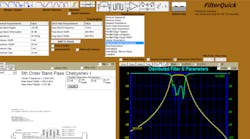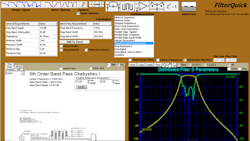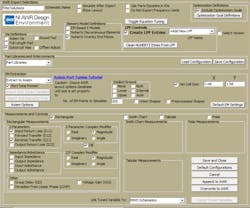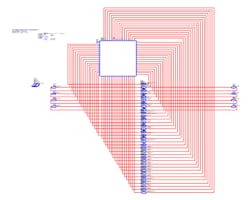Download this article as a .PDF
It goes without saying that filters are crucial for achieving acceptable RF/microwave system performance. For engineers who are tasked with designing filters, software tools are available to streamline the design process. This article dives into one such example by presenting a design process of a miniature hairpin resonator filter, which can be designed in a short amount of time thanks to the capabilities of current software tools.
One company that specializes in filter design software is Nuhertz Technologies. The company’s FilterSolutions software can be used to design lumped-element, distributed, active, and digital filters. In addition, FilterSolutions can be used together with various third-party electromagnetic (EM) simulators, as filter designs in FilterSolutions can be exported to third-party EM simulators for simulation and analysis.
In the example presented in this article, the Nuhertz FilterSolutions software will be used to design a microstrip miniature hairpin resonator filter.1 This filter design will then be exported to the AXIEM 3D planar EM simulator within the NI AWR Design Environment where it is optimized to obtain the desired performance. Nuhertz’s port tuning feature enables the overall design process to be completed in a short amount of time.2
As an overview, the design process involves first creating the filter in the FilterSolutions program. Next, the design is exported to AXIEM with the port tuning feature enabled (this feature will be explained in more detail later).
After being exported to AXIEM, the filter is then optimized with the port tuning feature enabled. Since the tuning process is iterative, the filter is then imported back into FilterSolutions and then re-exported to AXIEM with the port tuning feature still enabled. This process is repeated until desirable simulation results are achieved, which is usually accomplished in one to three cycles. Tuning ports rely on small perturbation adjustments for accuracy. Hence, the first pass tends to rough out the optimization, while the second pass tends to fine-tune it.
Once the desired performance is attained, the filter is imported back into FilterSolutions and then re-exported to AXIEM again, but without the port tuning feature enabled. By disabling the port tuning feature, the final EM model can be generated in AXIEM for simulation and fabrication.
Starting the Design Process
The FilterSolutions software lets users choose either quick or advanced user design panels. The quick panel, known as FilterQuick, is intended to provide a more simplified approach to designing filters and helps new users learn the tool. More advanced users are sure to take advantage of the comprehensive advanced design panel. Both panels support the port tuning feature.
For this example, FilterQuick is used. Figure 1 shows the parameters for this filter. Among them are a center frequency of 3 GHz and a stopband attenuation of 30 dB. Furthermore, the substrate for this filter is 10-mil-thick alumina. Figure 1 also shows the frequency response.
1. Shown here is the FilterQuick user interface. The parameters for the filter have been entered.
EM Analysis with the Port Tuning Feature
EM analysis is the next step in the design process. As stated earlier, filter designs in FilterSolutions can be exported to various third-party EM simulators. Exporting a filter is accomplished via the Export dropdown menu (Fig. 1). Clicking this dropdown menu reveals several options that users can choose from. For this example, AWR Setup is selected.
Selecting AWR Setup displays a subsequent user interface (Fig. 2). Extract to Axiem was then selected from the EM Extraction dropdown menu that can be seen in Figure 2. The Port Tune Format checkbox located directly underneath the EM Extraction dropdown menu was then checked. Additional options include setting the number of EM points to simulate, setting the cell size in AXIEM, and much more.
2. This is the user interface that is displayed after choosing AWR Setup.
Next, clicking Overwrite to Axiem exports the filter design to the AXIEM EM simulator. The filter is then generated in AXIEM in just a matter of seconds. Figure 3 shows the generated AXIEM EM layout.
3. Shown is the EM layout that is generated in AXIEM after exporting. In addition to the input and output ports, a large number of tuning ports are present here.
As can be seen in Fig. 3, internal ports are automatically incorporated into the AXIEM EM structure by enabling the port tuning feature during the filter exporting process. These internal ports provide connection points for tuning elements (components) located in strategic locations. The associated schematic in the AWR design environment contains the EM structure itself along with tuning elements that are connected to the tuning ports (Fig. 4). These tuning elements can be optimized to obtain the desired frequency response using parameters that are derived from tuning variables contained in the schematic.
4. The schematic contains the EM structure (large square) along with many tuning elements.
Figure 5 shows the results of the initial AXIEM simulation prior to optimizing the filter. The results of the EM simulation demonstrate that the filter should be optimized, since it appears that the response at the low end of the frequency range needs to be improved.
5. Shown are the initial AXIEM simulation results.
Optimizing the Filter
Optimizing the filter first requires specifying the optimization goals. FilterSolutions automatically produces its own default set of optimization goals. Of course, designers can also modify these goals to meet their own requirements. Figure 6 shows the optimization goals used here, one of which is an S11 of less than −18 dB from 2,854 to 3,154 MHz.
6. The optimization goals are shown here.
The average amount of time needed to optimize the filter in this case was approximately 52 sec. (note that this average was calculated after performing the optimization 10 consecutive times for verification purposes). Figure 7 shows the simulation results after optimization, revealing an improved frequency response.
7. Shown are the simulation results after optimization, illustrating an improved filter response.
Importing and Re-Exporting
The tuning process is iterative, meaning a few cycles are generally needed to obtain the desired performance. Hence, the next step is to return to the FilterSolutions software and select Import and Reexport Over from the user interface (Fig. 2). The filter is again generated in AXIEM with internal ports. However, while the EM layout of this newly generated filter essentially looks the same, it now has certain resonator dimensions that have been re-computed.
The associated schematic contains this new EM structure along with the tuning elements connected to the tuning ports. The same process of optimizing the filter is then repeated. Figure 8 shows the simulation results after optimization.
8. After selecting Import and Reexport Over in FilterSolutions, the filter was again optimized in AXIEM. Shown here are the simulation results.
As stated, the tuning process is iterative, as it may require a few cycles. Hence, the same process of returning to FilterSolutions and selecting Import and Reexport Over was performed again. However, the simulation results obtained after optimizing the filter once again remained almost the same as the results obtained after the previous optimization. Hence, this step may not have been necessary for this design.
Importing and Re-Exporting Without Port Tuning
Now that a desirable filter response has been achieved, the last step in the design process is to perform a final design verification using the EM simulator without the tuning elements. The internal ports are removed by disabling the port tuning feature in the FilterSolutions program by unchecking the Port Tune Format checkbox. Next, Import and Reexport Over is selected to export the filter into AXIEM again to confirm that the design goals have been met.
Figure 9 shows the generated AXIEM EM layout. As can be seen, the internal ports are no longer present due to disabling the port tuning feature. Figure 10 shows the associated schematic, which contains an EM extraction block. Figure 11 shows the simulation results of this filter, demonstrating good performance.
9. The filter is now generated in AXIEM without any tuning ports.
10. Shown is the schematic in the AWR design environment that includes an EM extraction block.
11. This figure illustrates the final simulation results of the filter.
To summarize, the port tuning feature is a fast and effective way of designing distributed filters. The design of a microstrip miniature hairpin resonator filter was presented in this article to validate this process. Those who are interested can take advantage of the software tools featured in this article to design their own filters.
References
- Shivhare, Jagdish. “A Compact Fourth-Order Multi-fold Hairpin Line Microstrip Bandpass Filter at 1650 Mhz for Rf Wireless Communications,” International Journal of Research in Engineering and Technology, May 2014, pp. 683-686.
- Rautio, James C. “Perfectly Calibrated Internal Ports in EM Analysis of Planar Circuits,” 2008 IEEE MTT-S International Microwave Symposium Digest, June 15-20, 2008, pp. 1,373-1,376.












